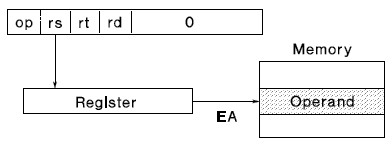The MIPS is a load/store machine—all values must be moved into the CPU from memory and placed into one of the general purpose registers before it can be used. The memory location of a value, as specified by the addressing mode, is called its effective address (EA). The table below summarizes the three addressing modes available in the MIPS processor.
| Mode | Syntax | Effective Address |
|---|---|---|
| Relative | relocatable symbol ± expression | EA = relocatable address ± expression |
| Register indirect | ($n) where $n: general purpose register n |
EA = [$n] = contents of $n |
| Base | offset($n) |
EA = [$n] + offset |
- Relative Addressing Mode
-
Address of operand is the relocatable address of a symbol added or subtracted by the value of an expression.
Note that (the instructor believes) the MARS and Spim are not able to handle the expression subtracted; e.g.,
val+1is fine in the following code, butval-1is not.
|

|
| Relative Addressing Mode | ||
|---|---|---|
.data
s: .asciiz "abc"
.text
la $a0, s+1
li $v0, 4
syscall
|
.data
val: .byte 1
.half 2
.word 3
.text
lh $a0, val+1
li $v0, 1
syscall
|
.data
val: .byte 1
.half 2
.word 3
.text
lb $a0, val+1
li $v0, 1
syscall
|
| Output | Output | Output |
|
I’m late for my best friend’s wedding. Put the pedal to the metal! (drive as fast as possible) |